The University of Cambridge (informally known as Cambridge University or Cambridge) is a public research university located in Cambridge, United Kingdom. It is the second-oldest university in the English-speaking world (after the University of Oxford), and the seventh-oldest in the world. In post-nominals the university's name is abbreviated as Cantab, a shortened form of Cantabrigiensis (an adjective derived from Cantabrigia, the Latinised form of Cambridge).
The university grew out of an association of scholars in the city of
Cambridge that was formed in 1209, early records suggest, by scholars
leaving Oxford after a dispute with townsfolk.[5] The two "ancient universities" have many common features and are often jointly referred to as Oxbridge. In addition to cultural and practical associations as a historic part of British society, they have a long history of rivalry with each other.
Cambridge ranks first in the world in both the 2010 and 2011 QS World University Rankings,[6] sixth in the world in the 2011 Times Higher Education World University Rankings, and fifth in the world (and first in Europe) in the 2011 Academic Ranking of World Universities. Cambridge regularly contends with Oxford for first place in UK league tables.[7][8][9] In the most recently published ranking of UK universities, published by The Guardian newspaper, Cambridge was ranked first.[10]
Graduates of the university have won a total of 65 Nobel Prizes, the most of any university in the world.[11]
In 2009, the marketing consultancy World Brand Lab rated Cambridge
University as the 50th most influential brand in the world, and the 4th
most influential university brand, behind only Harvard, MIT and Stanford University,[12]
while in 2011, Cambridge ranked third, after Harvard and MIT, in The
Times Higher Education World Reputation Rankings, which reflect the
reputation of universities for educational and research excellence
based on a survey of academics worldwide.[13]
Cambridge is a member of the Coimbra Group, the G5, the International Alliance of Research Universities, the League of European Research Universities and the Russell Group of research-led British universities. It forms part of the 'Golden Triangle' of British universities.[14]
History
Cambridge's status was enhanced by a charter in 1231 from King Henry III of England which awarded the ius non trahi extra (a right to discipline its own members) plus some exemption from taxes, and a bull in 1233 from Pope Gregory IX that gave graduates from Cambridge the right to teach everywhere in Christendom.[citation needed]After Cambridge was described as a studium generale in a letter by Pope Nicholas IV in 1290,[15] and confirmed as such in a bull by Pope John XXII in 1318, it became common for researchers from other European medieval universities to come and visit Cambridge to study or to give lecture courses.[citation needed]
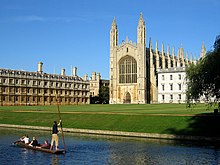
Foundation of the colleges
Cambridge's colleges were originally an incidental feature of the system. No college is as old as the university itself. The colleges were endowed fellowships of scholars. There were also institutions without endowments, called hostels. The hostels were gradually absorbed by the colleges over the centuries, but they have left some indicators of their time, such as the name of Garret Hostel Lane.Hugh Balsham, Bishop of Ely, founded Peterhouse in 1284, Cambridge's first college. Many colleges were founded during the fourteenth and fifteenth centuries, but colleges continued to be established throughout the centuries to modern times, although there was a gap of 204 years between the founding of Sidney Sussex in 1596 and Downing in 1800. The most recently established college is Robinson, built in the late 1970s. However, Homerton College only achieved full university college status in March 2010, making it the newest full college (it was previously an "Approved Society" affiliated with the university).
In medieval times, many colleges were founded so that their members would pray for the souls of the founders, and were often associated with chapels or abbeys. A change in the colleges’ focus occurred in 1536 with the Dissolution of the Monasteries. King Henry VIII ordered the university to disband its Faculty of Canon Law[16] and to stop teaching "scholastic philosophy". In response, colleges changed their curricula away from canon law and towards the classics, the Bible, and mathematics.
As Cambridge moved away from Canon Law, it also moved away from Catholicism. As early as the 1520s, Lutheranism and what was to become more broadly known as the Protestant Reformation were making their presence felt in the intellectual discourse of the university. Among the intellectuals involved was the theologically influential Thomas Cranmer, later to become Archbishop of Canterbury. As it became convenient to Henry VIII in the 1530s, the King looked to Cranmer and others (within and without Cambridge) to craft a new religious path that was different from Catholicism yet also different from what Martin Luther had in mind.
Nearly a century later, the university was at the centre of another Christian schism. Many nobles, intellectuals and even common folk saw the ways of the Church of England as being too similar to the Catholic Church and that it was used by the crown to usurp the rightful powers of the counties. East Anglia was the centre of what became the Puritan movement and at Cambridge, it was particularly strong at Emmanuel, St Catharine's Hall, Sidney Sussex and Christ's College.[17] They produced many "non-conformist" graduates who greatly influenced, by social position or pulpit, the approximately 20,000 Puritans who left for New England and especially the Massachusetts Bay Colony during the Great Migration decade of the 1630s. Oliver Cromwell, Parliamentary commander during the English Civil War and head of the English Commonwealth (1649–1660), attended Sidney Sussex.

Mathematics and Physics
From the time of Isaac Newton in the later 17th century until the mid-19th century, the university maintained a strong emphasis on applied mathematics, particularly mathematical physics. Study of this subject was compulsory for graduation, and students were required to take an exam for the Bachelor of Arts degree, the main first degree at Cambridge in both arts and science subjects. This exam is known as a Tripos. Students awarded first-class honours after completing the mathematics Tripos were named wranglers. The Cambridge Mathematical Tripos was competitive and helped produce some of the most famous names in British science, including James Clerk Maxwell, Lord Kelvin, and Lord Rayleigh. However, some famous students, such as G. H. Hardy, disliked the system, feeling that people were too interested in accumulating marks in exams and not interested in the subject itself.Pure mathematics at Cambridge in the 19th century had great achievements but also missed out on substantial developments in French and German mathematics. Pure mathematical research at Cambridge finally reached the highest international standard in the early 20th century, thanks above all to G. H. Hardy and his collaborator, J. E. Littlewood. In geometry, W. V. D. Hodge brought Cambridge into the international mainstream in the 1930s.
Although diversified in its research and teaching interests, Cambridge today maintains its strength in mathematics. Cambridge alumni have won six Fields Medals and one Abel Prize for mathematics, while individuals representing Cambridge have won four Fields Medals.[18] The University also runs a special Master of Advanced Study course in mathematics.
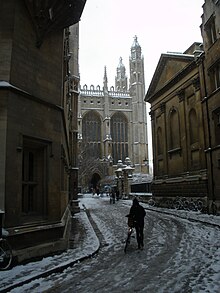
Contributions to the advancement of science
Many of the most important scientific discoveries and revolutions were made by Cambridge alumni. These include:- Understanding the scientific method, by Francis Bacon
- The laws of motion and the development of calculus, by Sir Isaac Newton
- The development of thermodynamics, by Lord Kelvin
- The discovery of the electron, by J. J. Thomson
- The splitting of the atom, by Ernest Rutherford and of the nucleus by Sir John Cockcroft and Ernest Walton
- The unification of electromagnetism, by James Clerk Maxwell
- The discovery of hydrogen, by Henry Cavendish
- Theory of Evolution by natural selection, by Charles Darwin
- Mathematical synthesis of Darwinian selection with Mendelian genetics, by Ronald Fisher
- The Turing machine, a basic model for computation, by Alan Turing
- The structure of DNA, by Rosalind Franklin, Francis Crick, James D. Watson and Maurice Wilkins, the latter three awarded the Nobel Prize. (Franklin did not receive the Nobel Prize as it is not given posthumously.)
- Pioneering quantum mechanics, by Paul Dirac
Women's education
Initially, only male students were enrolled into the university. The first colleges for women were Girton College (founded by Emily Davies) in 1869 and Newnham College in 1872 (founded by Anne Clough and Henry Sidgwick), followed by Hughes Hall in 1885 (founded by Elizabeth Phillips Hughes as the Cambridge Teaching College for Women), New Hall (later renamed Murray Edwards College) in 1954, and Lucy Cavendish College in 1965. The first women students were examined in 1882 but attempts to make women full members of the university did not succeed until 1947. Women were allowed to study courses, sit examinations, and have their results recorded from 1881; for a brief period after the turn of the twentieth century, this allowed the "steamboat ladies" to receive ad eundem degrees from the University of Dublin.From 1921 women were awarded diplomas which "conferred the Title of the Degree of Bachelor of Arts". As they were not "admitted to the Degree of Bachelor of Arts" they were excluded from the governing of the university. Since students must belong to a college, and since established colleges remained closed to women, women found admissions restricted to colleges established only for women. Starting with Churchill College, all of the men's colleges began to admit women between 1972 and 1988. One women's college, Girton, also began to admit male students from 1979, but the other women's colleges did not follow suit. As a result of St Hilda's College, Oxford, ending its ban on male students in 2008, Cambridge is now the only remaining United Kingdom University with colleges which refuse to admit males, with three such institutions (Newnham, Murray Edwards and Lucy Cavendish).[19][20] In the academic year 2004–5, the university's student gender ratio, including post-graduates, was male 52%: female 48%.[21]
Myths, legends and traditions
A discontinued tradition is that of the wooden spoon, the ‘prize’ awarded to the student with the lowest passing grade in the final examinations of the Mathematical Tripos. The last of these spoons was awarded in 1909 to Cuthbert Lempriere Holthouse, an oarsman of the Lady Margaret Boat Club of St John's College. It was over one metre in length and had an oar blade for a handle. It can now be seen outside the Senior Combination Room of St John's. Since 1909, results were published alphabetically within class rather than score order. This made it harder to ascertain who the winner of the spoon was (unless there was only one person in the third class), and so the practice was abandoned.
Each Christmas Eve, BBC radio and television broadcasts The Festival of Nine Lessons and Carols by the Choir of King's College, Cambridge. The radio broadcast has been a national Christmas tradition since it was first transmitted in 1928 (though the festival has existed since 1918). The radio broadcast is carried worldwide by the BBC World Service and is also syndicated to hundreds of radio stations in the USA. The first television broadcast of the festival was in 1954.[22][23]
Organisation

The faculties are responsible for ensuring that lectures are given, arranging seminars, performing research and determining the syllabi for teaching, overseen by the General Board. Together with the central administration headed by the Vice-Chancellor, they make up the entire Cambridge University. Facilities such as libraries are provided on all these levels: by the University (the Cambridge University Library), by the Faculties (Faculty libraries such as the Squire Law Library), and by the individual colleges (all of which maintain a multi-discipline library, generally aimed mainly at their undergraduates).
Colleges
Cambridge has 31 colleges, of which three, Murray Edwards, Newnham and Lucy Cavendish, admit women only. The other colleges are mixed, though most were originally all-male. Darwin was the first college to admit both men and women, while Churchill, Clare, and King's were the first previously all-male colleges to admit female undergraduates, in 1972. In 1988 Magdalene became the last all-male college to accept women.[24] Clare Hall and Darwin admit only postgraduates, and Hughes Hall, Lucy Cavendish, St Edmund's and Wolfson admit only mature (i.e. 21 years or older on date of matriculation) students, encompassing both undergraduate and graduate students. All other colleges admit both undergraduate and postgraduate students with no age restrictions.
Colleges are not required to admit students in all subjects, with some colleges choosing not to offer subjects such as architecture, history of art or theology, but most offer close to the complete range. Some colleges maintain a bias towards certain subjects, for example with Churchill leaning towards the sciences and engineering,[25] while others such as St Catharine's aim for a balanced intake.[26] Costs to students (accommodation and food prices) vary considerably from college to college.[27][28] Others maintain much more informal reputations, such as for the students of King's College to hold left-wing political views,[29] or Robinson College and Churchill College's attempts to minimise its environmental impact.[30]
There are also several theological colleges in Cambridge, separate from Cambridge University, including Westcott House, Westminster College and Ridley Hall Theological College, that are, to a lesser degree, affiliated to the university and are members of the Cambridge Theological Federation[31].
Teaching
Teaching involves a mixture of lectures, organised by the university departments, and supervisions, organised by the colleges. (Science subjects also involve laboratory sessions, organised by the departments.) The relative importance of these methods of teaching varies according to the needs of the subject. Supervisions are typically weekly hour-long sessions in which small groups of students (usually between one and three) meet with a member of the teaching staff or with a doctoral student. Students are normally required to complete an assignment in advance of the supervision, which they will discuss with the supervisor during the session, along with any concerns or difficulties they have had with the material presented in that week's lectures. The assignment is often an essay on a subject set by the supervisor, or a problem sheet set by the lecturer. Depending on the subject and college, students might receive between one and four supervisions per week. This pedagogical system is often cited[by whom?] as being unique to Cambridge and Oxford (where "supervisions" are known as "tutorials").A tutor named William Farish developed the concept of grading students' work quantitatively at the University of Cambridge in 1792.[32]
Schools, faculties and departments
In addition to the 31 colleges, the university is made up of over 150 departments, faculties, schools, syndicates and other institutions. Members of these are usually also members of one of the colleges and responsibility for running the entire academic programme of the university is divided amongst them.A "School" in the University of Cambridge is a broad administrative grouping of related faculties and other units. Each has an elected supervisory body—the "Council" of the school—comprising representatives of the constituent bodies. There are six schools:[33]
- Arts and Humanities
- Biological Sciences
- Clinical Medicine
- Humanities and Social Sciences
- Physical Sciences
- Technology
Academic year
The academic year is divided into three academic terms, determined by the Statutes of the University.[34] Michaelmas Term lasts from October to December; Lent Term from January to March; and Easter Term from April to June.Within these terms undergraduate teaching takes place within eight-week periods called Full Terms. These terms are shorter than those of many other British universities.[35] Undergraduates are also expected to prepare heavily in the three holidays (known as the Christmas, Easter and Long Vacations).
Central administration
Chancellor and Vice-Chancellor
The office of Chancellor of the University, for which there are no term limits, is mainly ceremonial and is held by David Sainsbury, Baron Sainsbury of Turville, following the retirement of the Duke of Edinburgh on his 90th birthday in June, 2011. Lord Sainsbury was nominated by the official Nomination Board to succeed him,[36] and Abdul Arain, owner of a local grocery store, Brian Blessed and Michael Mansfield were also nominated.[37][38][39] The election took place on 14 and 15 October 2011.[39] David Sainsbury won the election taking 2,893 of the 5,888 votes cast, winning on the first count.The current Vice-Chancellor is Leszek Borysiewicz. While the Chancellor's office is ceremonial, the Vice-Chancellor is the de facto principal administrative officer of the University. The university's internal governance is carried out almost entirely by its own members,[40] with very little external representation on its governing body, the Regent House (though there is external representation on the Audit Committee, and there are four external members on the University's Council, who are the only external members of the Regent House).[41]
Senate and the Regent House
The Senate consists of all holders of the MA degree or higher degrees. It elects the Chancellor and the High Steward, and elected two members of the House of Commons until the Cambridge University constituency was abolished in 1950. Prior to 1926, it was the University's governing body, fulfilling the functions that the Regent House fulfils today.[42] The Regent House is the University's governing body, a direct democracy comprising all resident senior members of the University and the Colleges, together with the Chancellor, the High Steward, the Deputy High Steward, and the Commissary.[43] The public representatives of the Regent House are the two Proctors, elected to serve for one year, on the nomination of the Colleges.Council and the General Board
Although the University Council is the principal executive and policy-making body of the University, therefore, it must report and be accountable to the Regent House through a variety of checks and balances. It has the right of reporting to the University, and is obliged to advise the Regent House on matters of general concern to the University. It does both of these by causing notices to be published by authority in the Cambridge University Reporter, the official journal of the University. Since January 2005, the membership of the Council has included two external members,[44] and the Regent House voted for an increase from two to four in the number of external members in March 2008,[45][46] and this was approved by Her Majesty the Queen in July 2008.[47]
Faculty Boards are responsible to the General Board; other Boards and Syndicates are responsible either to the General Board (if primarily for academic purposes) or to the Council. In this way, the various arms of the University are kept under the supervision of the central administration, and thus the Regent House.
Finances
Cambridge is by far the wealthiest university in the UK and in the whole of Europe, with an endowment of £4.3 billion in 2011.[49][50] This is made up of around £1.6 billion tied directly to the university and £2.7 billion to the colleges.[49] As of 2011, Oxford had an endowment valued at around £3.3 billion.[49] The university's operating budget is well over £1 billion per year.[51] Each college is an independent charitable institution with its own endowment, separate from that of the central university endowment. If ranked on a US university endowment table on most recent figures, Cambridge would rank fourth in a ranking compared with the eight Ivy League institutions (subject to market fluctuations).[49]Comparisons between Cambridge's endowment and those of other top US universities are, however, inaccurate because being a state-funded public university (although the status of Cambridge as a public university can not be compared with US or European public universities as, for example, the state do not "own" the university), Cambridge receives a major portion of its income through education and research grants from the British Government. In 2006-7, it was reported that approximately one third of Cambridge's income comes from UK government funding for teaching and research, with another third coming from other research grants. Endowment income contributes around £130 million. The University also receives a significant income in annual transfers from the Cambridge University Press, which is the oldest, and second largest university press in the world.[52]
[edit] Benefactions and fundraising
In 2000, Bill Gates of Microsoft donated US$210 million through the Bill and Melinda Gates Foundation to endow the Gates Scholarships for students from outside the UK seeking postgraduate study at Cambridge.[53] The University of Cambridge Computer Laboratory, which taught the world's first computing course in 1953, is housed in a building partly funded by Gates and named after his father, William Gates.[citation needed]In 2005, the Cambridge 800th Anniversary Campaign was launched, aimed at raising £1 billion by 2012—the first US-style university fund-raising campaign in Europe. This aim was reached in the financial year 2009-2010, with raising £1.037 billion.[54]
Collections
Libraries and museums
The university has 114 libraries.[55] The Cambridge University Library is the central research library, which holds over 8 million volumes and, in contrast with the Bodleian or the British Library, many of its books are available on open shelves, and most books are borrowable. It is a legal deposit library, therefore it is entitled to request a free copy of every book published in the UK and Ireland. It receives around 80,000 books every year, not counting the books donated to the library. In addition to the University Library and its dependent libraries, every faculty has a specialised library, which, on average, holds from 30,000 to 150,000 books; for example the History Faculty's Seeley Historical Library posess more than 100,000 books. Also, every college has a library as well, partially for the purposes of undergraduate teaching, and the older colleges often possess many early books and manuscripts in a separate library. For example Trinity College's Wren Library has more than 200,000 books printed before 1800, while Corpus Christi College's Parker Library posesses one of the greatest collections of medieval manuscripts in the world, with over 600 manuscripts. The total number of books owned by the university is about 12 million.Cambridge University operates eight arts, cultural, and scientific museums, and a botanic garden:
- The Fitzwilliam Museum, is the art and antiquities museum
- The Kettle's Yard is a contemporary art gallery
- The Museum of Archaeology and Anthropology, University of Cambridge houses the University's collections of local antiquities, together with archaeological and ethnographic artifacts from around the world
- The Cambridge University Museum of Zoology
- The Museum of Classical Archaeology, Cambridge
- The Whipple Museum of the History of Science
- The Sedgwick Museum of Earth Sciences is the geology museum of the University
- The Scott Polar Research Institute comprises the Polar Museum, dedicated to the Arctic and Antarctic exploration
- The Cambridge University Botanic Garden is the botanic garden of the university, created in 1831
Academics

Research
Cambridge University has research departments and teaching faculties in most academic disciplines, and spends around £650 million in a year for research. All research and lectures are conducted by University Departments. The colleges are in charge of giving or arranging most supervisions, student accommodation, and funding most extracurricular activities. During the 1990s Cambridge added a substantial number of new specialist research laboratories on several University sites around the city, and major expansion continues on a number of sites.[56]Cambridge is a member of the Russell Group, a network of research-led British universities; the Coimbra Group, an association of leading European universities; the League of European Research Universities; and the International Alliance of Research Universities. It is also considered part of the "Golden Triangle", a geographical concentration of UK university research.
Building on its reputation for enterprise, science and technology, Cambridge has a partnership with MIT in the United States, the Cambridge–MIT Institute.
Admissions
Procedure
The application system to Cambridge and Oxford involves additional requirements, with candidates typically called to face-to-face interviews.How applicants perform in the interview process is an important factor in determining which students are accepted.[57] Most applicants are expected to be predicted at least three A-grade A-level qualifications relevant to their chosen undergraduate course, or equivalent overseas qualifications, such as getting at least 7,7,6 for higher-level subjects at IB. The A* A-level grade (introduced in 2010) now plays a part in the acceptance of applications, with the university's standard offer for all courses being set at A*AA.[58][59] Due to a very high proportion of applicants receiving the highest school grades, the interview process is crucial for distinguishing between the most able candidates.[57] In 2006, 5,228 students who were rejected went on to get 3 A levels or more at grade A, representing about 63% of all applicants rejected.[60] The interview is performed by College Fellows, who evaluate candidates on unexamined factors such as potential for original thinking and creativity.[57] For exceptional candidates, a Matriculation Offer is sometimes offered, requiring only two A-levels at grade E or above—Christ's College is unusual in making this offer to about one-third of successful candidates, in order to relieve very able candidates of some pressure in their final year.[citation needed]
Strong applicants who are not successful at their chosen college may be placed in the Winter Pool, where they can be offered places by other colleges. This is in order to maintain consistency throughout the colleges, some of which receive more applicants than others.
Graduate admission is first decided by the faculty or department relating to the applicant's subject. This effectively guarantees admission to a college—though not necessarily the applicant's preferred choice.[61]
[edit] Access
Public debate in the United Kingdom continues over whether admissions processes at Oxford and Cambridge are entirely merit based and fair; whether enough students from state schools are encouraged to apply to Cambridge; and whether these students succeed in gaining entry. In 2007–08, 57% of all successful applicants were from state schools[62] (roughly 93 percent of all students in the UK attend state schools). However, the average qualifications for successful applicants from state schools are slightly lower than the average qualification of successful applicants from private schools.[citation needed] Critics have argued that the lack of state school applicants with the required grades applying to Cambridge and Oxford has had a negative impact on Oxbridge's reputation for many years, and the University has encouraged pupils from state schools to apply for Cambridge to help redress the imbalance.[citation needed] Others counter that government pressure to increase state school admissions constitutes inappropriate social engineering.[63][64] The proportion of undergraduates drawn from independent schools has dropped over the years, and such applicants now form a (very large) minority (43%)[62][65] of the intake. In 2005, 32% of the 3599 applicants from independent schools were admitted to Cambridge, as opposed to 24% of the 6674 applications from state schools.[66] In 2008 the University of Cambridge received a gift of £4m to improve its accessibility to candidates from maintained schools.[67] Cambridge, together with Oxford and Durham, is among those universities that have adopted formulae that gives a rating to the GCSE performance of every school in the country to "weight" the scores of university applicants.[68]Both the University's central Student Union, and individual college student unions (JCRs) run student led Access schemes aimed at encouraging applications to the University from students at schools with little or no history of Oxbridge applications, and from students from families with little or no history of participation in university education.
Reputation

The university is also closely linked with the development of the high-tech business cluster in and around Cambridge, which forms the area known as Silicon Fen or sometimes the "Cambridge Phenomenon". In 2004, it was reported that Silicon Fen was the second largest venture capital market in the world, after Silicon Valley. Estimates reported in February 2006 suggest that there were about 250 active startup companies directly linked with the university, worth around US$6 billion.[73]







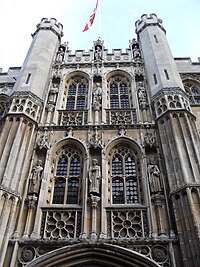

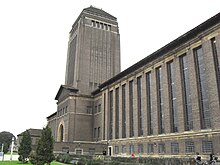

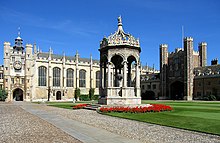
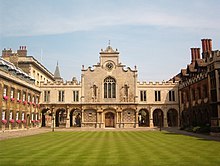





0 komentar:
Posting Komentar